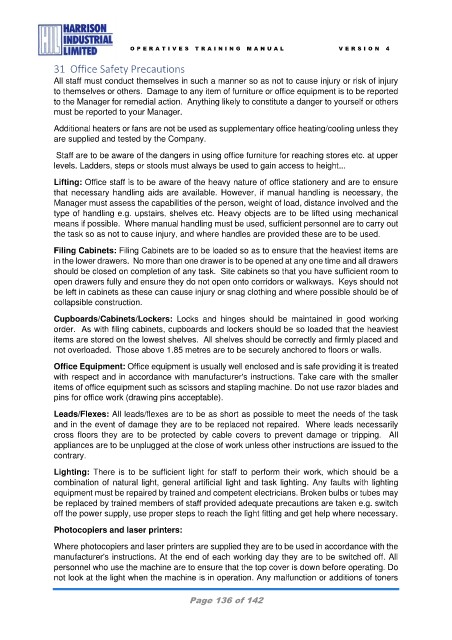Page 137 - HIL Operatives Training Manual V4 16022024_Neat
P. 137
O P E R A T I V E S T R A I N I N G M A N U A L V E R S I O N 4
31 Office Safety Precautions
All staff must conduct themselves in such a manner so as not to cause injury or risk of injury
to themselves or others. Damage to any item of furniture or office equipment is to be reported
to the Manager for remedial action. Anything likely to constitute a danger to yourself or others
must be reported to your Manager.
Additional heaters or fans are not be used as supplementary office heating/cooling unless they
are supplied and tested by the Company.
Staff are to be aware of the dangers in using office furniture for reaching stores etc. at upper
levels. Ladders, steps or stools must always be used to gain access to height...
Lifting: Office staff is to be aware of the heavy nature of office stationery and are to ensure
that necessary handling aids are available. However, if manual handling is necessary, the
Manager must assess the capabilities of the person, weight of load, distance involved and the
type of handling e.g. upstairs, shelves etc. Heavy objects are to be lifted using mechanical
means if possible. Where manual handling must be used, sufficient personnel are to carry out
the task so as not to cause injury, and where handles are provided these are to be used.
Filing Cabinets: Filing Cabinets are to be loaded so as to ensure that the heaviest items are
in the lower drawers. No more than one drawer is to be opened at any one time and all drawers
should be closed on completion of any task. Site cabinets so that you have sufficient room to
open drawers fully and ensure they do not open onto corridors or walkways. Keys should not
be left in cabinets as these can cause injury or snag clothing and where possible should be of
collapsible construction.
Cupboards/Cabinets/Lockers: Locks and hinges should be maintained in good working
order. As with filing cabinets, cupboards and lockers should be so loaded that the heaviest
items are stored on the lowest shelves. All shelves should be correctly and firmly placed and
not overloaded. Those above 1.85 metres are to be securely anchored to floors or walls.
Office Equipment: Office equipment is usually well enclosed and is safe providing it is treated
with respect and in accordance with manufacturer's instructions. Take care with the smaller
items of office equipment such as scissors and stapling machine. Do not use razor blades and
pins for office work (drawing pins acceptable).
Leads/Flexes: All leads/flexes are to be as short as possible to meet the needs of the task
and in the event of damage they are to be replaced not repaired. Where leads necessarily
cross floors they are to be protected by cable covers to prevent damage or tripping. All
appliances are to be unplugged at the close of work unless other instructions are issued to the
contrary.
Lighting: There is to be sufficient light for staff to perform their work, which should be a
combination of natural light, general artificial light and task lighting. Any faults with lighting
equipment must be repaired by trained and competent electricians. Broken bulbs or tubes may
be replaced by trained members of staff provided adequate precautions are taken e.g. switch
off the power supply, use proper steps to reach the light fitting and get help where necessary.
Photocopiers and laser printers:
Where photocopiers and laser printers are supplied they are to be used in accordance with the
manufacturer's instructions. At the end of each working day they are to be switched off. All
personnel who use the machine are to ensure that the top cover is down before operating. Do
not look at the light when the machine is in operation. Any malfunction or additions of toners
Page 136 of 142

